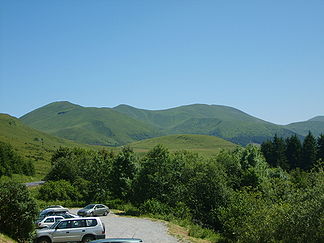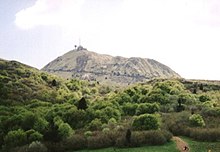Massif Central
| Massif Central | |
|---|---|
|
Location of the Massif Central in France |
|
| Highest peak | Puy de Sancy ( 1885 m ) |
| location | Auvergne ( France ) |
| Coordinates | 45 ° 32 ' N , 2 ° 49' E |
| surface | 85,000 km² |
The Massif Central ( French Massif central , Occitan Massís central ) is a mountain range in the middle of southern France , with an area of 85,000 km 2, about 15 percent of the country. It takes its name because of its central location in southern France . With an average height of 700 meters and a maximum height of 1885 meters in the Monts Dore , it is higher than the German low mountain range.
In the literature, the geographical delimitation of the Massif Central is not uniform, and sometimes only the volcanic area is referred to as such. In geology, the definition extends to the Variscan basement. Geomorphologically, the border to the surrounding landscapes in the east and south is relatively clear, if one includes the mountain range of the Cevennes , since the terrain to these rises abruptly. The northernmost branch is the Beaujolais until shortly before Mâcon , the southernmost point is the Montagne Noire on the border with the Aude department - both still peak at an altitude of over 1000 meters. In the north and west the transition is smoother, the relief steps there in several steps. Limousin , Marche and Bourbonnais are the names of the landscapes in which the massif borders on the limestone surfaces and alluvial plains , which are grouped like a crescent around the mountain ranges, of which the Plateau de Millevaches , also almost 1000 meters high, is the farthest western high level. In this article, the area within these boundaries is referred to as the Massif Central.
The Massif Central is by no means a geographical unit, but can be divided into several highly differentiated regions due to differences in climate and soil conditions. The Auvergne , the land of volcanoes, the high, rough Cevennes , the barren and yet Mediterranean limestone plateaus, called Causses , and finally, so far to the south that it is often no longer included, the mountainous part of Languedoc- Roussillon . The history, culture and economy of the massif are as varied as the natural conditions.
Geographical location
The Massif Central is located west of the Rhone and is roughly bounded by the cities of Limoges, Clermont-Ferrand, Lyon, Nîmes, Béziers, Toulouse, Cahors, Périgueux and Angoulême; thus the massif extends to the regions Auvergne-Rhône-Alpes , Nouvelle-Aquitaine and Occitania . There it includes all or part of the departments
- Auvergne-Rhône-Alpes: Ardèche , Loire , Rhône , Allier , Cantal , Haute-Loire and Puy-de-Dôme ,
- Nouvelle-Aquitaine: Corrèze , Creuse , Haute-Vienne and Dordogne (partially),
- Occitania: Aveyron , Lot (partially), Tarn , Gard , Hérault and Lozère .
The largest cities in the massif are Saint-Étienne , Clermont-Ferrand and Limoges . Several stages of the Tour de France take place here regularly . A well-known wine from this area is the Beaujolais .
Geology of the Massif Central
The earliest geological traces can be dated to around 550 million years. At this time of the beginning of the Cambrian , the Massif Central seems to have belonged to a large system of thresholds that separated two seas. Removal debris has been preserved here, partially penetrated by granitic intrusions . In the Ordovician , around 480 to 440 million years ago, a ditch sank and widened to a broad ocean in which above all thick layers of clayey deep-sea sediments were deposited. 420 million years ago, on the threshold from the Silurian to the Devonian , Gondwana pushed its way back to Central Europe. Most of the sea floor was subducted and some sedimentary covers were also transported. With that a gigantic fold mountains rose up , the Variscan mountains. It stretched over the entire (present-day) eastern edge of North America, which at that time bordered Europe, across Central and Eastern Europe and was probably much more powerful than the present-day Alps. Sediments were transported to great depths and metamorphosed . Magma rose at the subduction zone .
As soon as the Variscan mountains rose, they began to erode . Mighty layers of rubble were deposited in the foreland, which the meandering rivers turned into a swamp. That took place in the carbon . Large, lush carbon forests developed in this swamp. Coal layers formed in these areas.
With the Alpidic folding in the Tertiary , a second elevation of the terrain occurred: The collision of the African and Eurasian plates led to the sea floor, on which limestone layers several hundred meters thick, and the granite base had formed, being pushed up again. These limestone plateaus form today's Causses, the geologically younger regions of the Massif Central. These were mainly formed in the Mesozoic - especially in the Jurassic Period - and rise in steps from northwest to southeast: while they only reach a height of around 200 meters in the Périgord and Quercy and are therefore not part of the actual Massif Central, they are over 1000 meters in the Lozère department high. Several rivers, particularly the Tarn , have carved gorges of enormous depth between them.
Lava reappeared in the late Tertiary along a collapse in the north, the Limagne . These now extinct volcanoes form a mighty chain of steep basalt peaks west of Clermont-Ferrand, the so-called Chaîne des Puys . The most famous volcano is the Puy de Dôme, which gave the department its name.
Relief and partial mountains
The north-west between Limoges and Clermont-Ferrand is initially determined by the gradually rising terrain of the Haut-Limousin, which culminates on the plateau de Millevaches in Mont Bessou (977 m). This is followed by the Auvergne, whose most important elevations are the Chaîne des Puys with the Puy de Dôme (1465 m), the massif of the Monts Dore with the Puy de Sancy (1886 m, highest elevation of the Massif Central) and the Cantal with the Plomb du Cantal (1858 m) are. The Auvergne continues east of Clermont-Ferrand: to the north with the Montagne de la Madeleine (1292 m), followed by the Monts du Forez (1634 m) and the mountainous regions of the Livradois and the Vélay . The eastern edge is formed from north to south by the Beaujolais , the Lyonnais and the Vivarais (up to 1754 m), to which the Cevennes connect. These culminate in Mont Lozère , at 1699 m the highest non-volcanic mountain in the Massif Central. To the west of it are the Causses, the highest point of which on the Causse Méjean is 1250 m. The Rouergue , the Albigeois , the Monts de Lacaune , the Monts de l'Espinouse and the Montagne Noire form the southernmost part, which rises to over 1200 m.
Highest mountains
Mountains in the Massif Central over 1500 m:
- Puy de Sancy (1885 m), highest point of the Monts Dore and the Puy-de-Dôme department
- Plomb du Cantal (1855 m), highest point of the Cantal department and the Monts du Cantal
- Puy Ferrand (1854 m)
- Puy de Peyre-Ass (1806 m)
- Puy Mary (1783 m)
- Mont Mézenc (1753 m), highest point in the Haute-Loire and Ardèche departments
- Pic de Finiels (1699 m), is the highest peak of the Mont Lozère massif
- Mont d'Alambre (1691 m)
- Puy Griou (1690 m)
- Pierre-sur-Haute (1631 m), highest point of the Monts du Forez and the Loire department
- Suc de Taupernas (1609 m)
- Suc de Montfol (1601 m)
- Suc de la Lauzière (1582 m)
- Mont Aigoual (1567 m)
- Truc de Fortunio (1552 m)
- Signal du Luguet (1551 m)
- Mont Gerbier-de-Jonc (1551 m)
- Les Valadous (1548 m)
- Les Sépoux (1535 m)
- Suc de Sara (1520 m)
- Grand Tanargue (1511 m)
traffic
The Central Massif is accessed by the Cevennes Railway and the A 75 Autoroute .
climate
The central massif is mostly in the moderate climatic zone, only the southern edge is already included in the subtropical climatic zone of the Mediterranean type. The climate manifests itself in both zones as the respective variant of the higher altitudes, i.e. In other words, it is cooler and more humid than the standard climate overall. Temperatures tend to decrease with altitude and exposure to the north, whereas precipitation increases with altitude and exposure to the west. Due to the diverse relief, there are many small-scale climates, especially where subsidence or river valleys have created protected areas.
Cold poles in the Massif Central are therefore the highest points in the massifs of Monts Dore and the Cantal as well as the Plateau de Millevaches due to its exposed north-west location. Heat islands are the Limagne with Clermont-Ferrand, Riom and Montluçon in the north, the Brive basin in the southwest and the eastern and southern flanks of the peripheral mountains, which merge into the Rhone Valley and Languedoc .
Correspondingly, the temperature profile and precipitation are represented over the course of the year:
- Limoges is located on the north-western edge of the massif at an altitude of almost 400 meters and has a still maritime climate with abundant precipitation concentrated in the winter half-year and a low annual amplitude .
- Average temperature: 11.8 ° C
- Maximum temperature: 19.8 ° C in August
- Minimum temperature: 5.2 ° C in January
- Maximum precipitation: late autumn
- Clermont-Ferrand is almost at the same latitude, at 332 meters a little lower and in the protected rift valley of the Limagne. The climate is central European type with humid, warm summers and still mild winters.
- Average temperature: 12.3 ° C
- Maximum temperature: 20.8 ° C in August
- Minimum temperature: 4.6 ° C in January
- Maximum precipitation: spring / summer
-
Due to its significantly higher, albeit more southerly location of 832 meters, Le Puy is already characterized by a harsher climate.
- Average temperature: 9.1 ° C
- Maximum temperature: 17.6 ° C in August
- Minimum temperature: 1.6 ° C in January
- Maximum precipitation: summer half-year
All information relates to the average values for the years 1997–2002.

literature
- Rudolf Michna: Massif Central. Marginality in the middle of France. (= Problem areas of Europe, Vol. 12) Cologne 1993. 51pp.
- AG Smith, AM Hurley, JC Briden: Paleocontinental World Maps of the Phanerozoic. Stuttgart 1982, ISBN 3-432-92841-6
- Jean Dercourt: Géologie et géodynamique de la France: Outre-mer et européenne. Dunod, Collection: Sciences Sup, 2002, ISBN 2-10-006459-2
- Rudolf Hohl (ed.): The history of the development of the earth. Leipzig 1989, ISBN 3-325-00100-9
- Cevennes. Roches, geology et paysages du Parc National des Cévennes. Revue du Parc National des Cévennes. 1985
- Parc National des Cevennes. Guides Gallimard, Paris 2007, ISBN 2-7424-1761-3
- Hubert Bril: Découverte géologique du Massif Central. Orleans 1997, ISBN 7-159-04150-X
- Johannes Baier: The Chaîne des Puys in the Auvergne . - In: Fossils 37 (2): 46-56; 2020.


